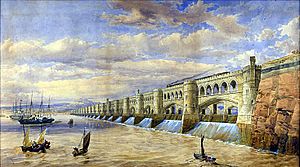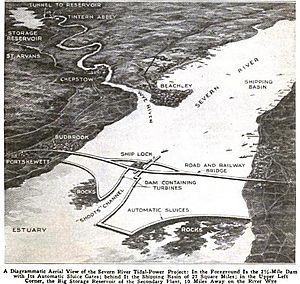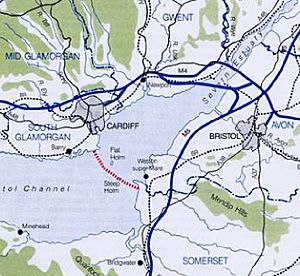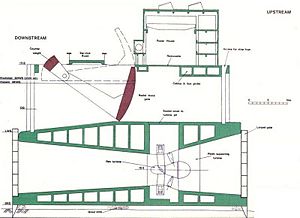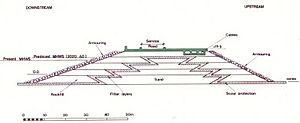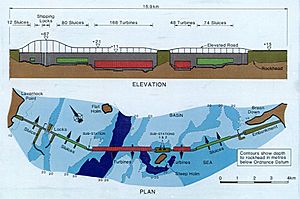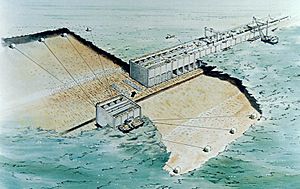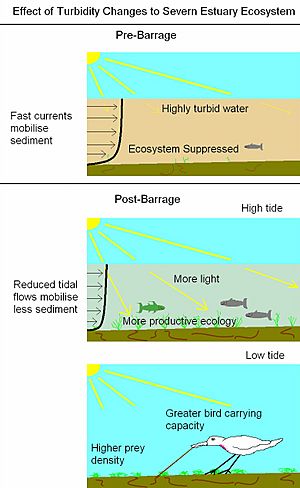Severn Barrage facts for kids
The Severn Barrage is a big idea for building a wall, called a barrage, across the Severn estuary between England and Wales. People have thought about building such a wall since the 1800s. It would be a huge engineering project, like some of the biggest in the world.
Originally, people thought about it for things like creating a safe harbour, protecting against floods, or making new transport routes. But in recent years, the main reason has been to generate electricity from the tides. The other benefits are now seen as useful side effects.
After a study from 2008 to 2010, the British government decided there wasn't a strong enough reason to build a barrage. However, they said they would keep looking into newer technologies. In 2013, a group of politicians also said the idea wasn't proven to be economically strong enough. They also worried about its effects on the environment.
Contents
History of the Severn Barrage
Over the years, many different plans have been suggested for the Severn Barrage. At first, the goal was to create a safe harbour. More recently, the main aim has been to make electricity.
Early Ideas for a Barrage
In 1849, an engineer named Thomas Fulljames suggested building a barrage about 1 mile (1.6 km) long. This was before electricity was common. So, his ideas focused on creating a large shipping harbour, new roads and railways, and protecting against floods.
Fulljames's ideas were not built. About 75 years later, in 1925, an official group studied the idea again. They knew the Severn has a huge tidal range (how much the water level changes between high and low tide) of 14 metres (46 feet). This is one of the biggest tidal ranges in the world. They suggested making 800 Megawatts (MW) of electricity. This was possible, but it was too expensive at the time.
In 1931, a Russian inventor named Paul Shishkoff showed a small working model of a tidal generator. It could spread the power output over 24 hours. The full barrage was estimated to cost £5 million back then.
Another government study in 1948 looked at barrage options. They thought it would cost £60 million to build. By 1953, the estimated cost had jumped to £200 million.
In 1971, an expert named Dr. Tom Shaw suggested a barrage from Brean Down to Lavernock Point. This plan was estimated to cost £500 million.
Bondi Committee Study—1981
After a big energy crisis in 1979, the plans were looked at again in 1981 by the "Bondi Committee." This group studied six possible places for a barrage. They suggested a 10-mile (16 km) long barrage between Brean Down and Lavernock Point. This barrage could have made 7,200 MW of power when the tides flowed. This plan was later used by another group, the Severn Tidal Power Group.
Shoots Barrage Idea—1987
In 1984, a company called Wimpey Atkins suggested a smaller barrage at English Stones. They hoped this would be cheaper and cause less environmental harm.
However, this study didn't deal with the problem of silt (mud and sand) building up. So, in 1987, Arthur Hooker and Parsons Brinckerhoff updated the plan for English Stones to handle the silt issue better.
This plan, now called the "Shoots Barrage," would cost about £1.4 to £1.8 billion to build today. It could generate 2.75 TWh of power each year. At its best, it could produce 1,050 MW.
This barrage would be located just below the Second Severn Crossing. This means smaller locks would be needed for ships to reach docks further up the river. The larger ports of Portbury and Avonmouth would not be affected.
Severn Tidal Power Group—1989
The Severn Tidal Power Group (STPG) did a big study in 1989. They agreed that the 1981 location was the best. They thought the barrage could produce 8,640 MW of power when the tide flowed, or 2,000 MW on average. This would provide 17 TWh of power each year. This is about 6% of the UK's electricity use. It would be like replacing 18 million tons of coal or 3 nuclear power plants.
The cost in 1989 was about £8 billion. The barrage would use technology already used in other tidal power plants around the world. Power would be made most efficiently when the tide flows in one direction. The barrage would reduce how far the tide goes out, but high tides would not be affected.
The barrage would have 216 turbines, each making 40 MW. It would also have sluices (gates) to let the tide in. Then, the gates would close to force the water out through the turbines. This creates pressure that makes the turbines work better.
The barrage would include shipping locks for large container ships. Building it would take about eight years and employ 35,000 people. The barrage would last at least 120 years, much longer than a nuclear power plant.
The STPG study said the electricity from the barrage would be worth the cost if it was seen as "green" energy. They also said the environmental impact was acceptable. However, the government at the time decided not to build it. Since then, worries about global warming and rising energy costs have made the idea seem more appealing again.
Severn Tidal Reef—2007
Evans Engineering suggested a new idea called a Severn Tidal "Reef." This design tries to avoid the environmental problems of a traditional barrage. It's like a mix between a barrage and a "tidal fence" (a line of tidal-stream turbines). The reef works with a much smaller change in water level, only about 2 metres (6.6 feet). This reduces its impact on the estuary.
Government Study Announced—2007
In 2007, the UK government announced a two-year study to see if a tidal power scheme in the Severn Estuary was possible. This study looked at different technologies, including barrages, lagoons, and new designs like tidal fences and reefs.
The study aimed to gather information to help the government decide if it should support a tidal power plan. It looked at environmental impacts, engineering, costs, and how it would affect the local area.
The study finished its first part in 2009 with a public discussion. In 2010, the government announced that it was stopping the project.
Corlan Hafren Proposal—2011
In 2011, a private group called Corlan Hafren suggested building a privately funded barrage. This idea was supported by politician Peter Hain. However, the plan failed after it was rejected by several groups of politicians and the government. In 2014, the leaders of Hafren Power resigned, ending this project.
Economic Impact of the Barrage
How Much Power Could It Make?
The Severn Barrage could provide a steady source of clean energy for a very long time. The 10-mile version could produce up to 5% of the UK's electricity. This would help the UK reach its goals for renewable energy and fight climate change. This is because the barrage doesn't burn fossil fuels, so it produces very few carbon emissions.
It could operate for about 120 years, which is twice as long as nuclear power plants. It would also help the UK have a more secure energy supply.
However, the power output depends on the tidal cycle.
- There are two high and two low tides each day, about every 24 hours and 50 minutes. Power is generated a few hours after each high tide.
- There's also a 29.5-day cycle where the lowest power days produce only about 25% of the power of the highest days.
Overall, power would be generated for just under eight hours each day.
How Much Would It Cost?
The estimated costs for different plans range from £10 billion to £34 billion. Some studies suggest that smaller projects could be paid for by private companies. This means the cost and risk would be between the company and their banks. Larger projects would likely need a lot of government help.
If a project goes ahead, the cost of the electricity produced might be higher for consumers. There could also be other costs, like changing existing ports or creating new habitats for wildlife. However, there would also be benefits, like flood protection, which would save taxpayer money in other ways.
For comparison, the Hinkley Point C nuclear power station will cost £25 billion and produce 3.2 GW of power.
Local Effects
A large barrage could create calm water conditions behind it, which might be good for some water activities. However, the water level would still change by about 10 metres (33 feet), which could be dangerous for people using the water.
The barrage would protect the Severn estuary from storm surges from the sea. But it could also make flooding worse upstream by blocking water drainage. Higher water levels downstream might also cause flooding in areas like the Somerset Levels.
New road or rail links could be built across a barrage, which would help local economies by boosting construction, tourism, and transport.
However, shipping would have to use locks, and the reduced water depth might stop some ships from reaching docks in Wales and Bristol. This could put thousands of jobs at risk. Other industries in the estuary, like fishing, would also be harmed.
Environmental Impact
The Severn Estuary is a very important natural area, especially for its wildlife. It's a "Special Area of Conservation" because of its importance in Europe. The muddy areas between high and low tide provide food for over 85,000 migrating and wintering water birds.
The RSPB is against any Severn Barrage. They say it would greatly harm the feeding grounds that these 85,000 birds rely on. They believe there wouldn't be enough space or food for the birds to survive.
The strong tidal currents in the estuary stir up silt (fine mud and sand). This makes the water cloudy and blocks sunlight, meaning there isn't much plant or fish life. A barrage would reduce these currents.
The barrage would not create a calm "lagoon" as some people think. Tidal power stations need the tide to flow through them. However, the tidal range in the Severn would be cut in half. Some people worry that fish migration would be difficult, but others disagree. The famous Severn bore (a wave that forms on the river) would also disappear.
A barrage could also cause coastal erosion in some areas and might not look good in the landscape. Building it would also require a huge amount of concrete and other materials, which would impact other areas where these materials are sourced.
Alternatives to a Barrage
Tidal Lagoon Idea
Friends of the Earth supports making power from tides but is against barrages because of their environmental impact. They suggest building man-made "tidal lagoons" in the estuary. These lagoons would fill and drain through turbines. Their plans would cover up to 60% of the area a barrage would. In some smaller designs, these lagoons would not hold back water in the sensitive wildlife areas.
Tidal Fence Idea
Another idea is to build one or more tidal fences across the Severn estuary. These fences would generate power using tidal stream generators. This idea is supported by the Severn Tidal Fence Consortium.
A tidal fence would try to make as much power as possible while still allowing ships to reach Cardiff and Bristol. It would also let wildlife keep their existing homes. This group thinks it would cost £3.5 billion to build an outer fence. This fence could generate 1.3 GW or 3.5 TWh each year.
The fence would allow salmon to migrate and would only slightly affect the mudflats used by migrating birds. It could also greatly reduce the risk of floods in the Severn estuary.
Transport Links Across the Barrage
Some types of barrages could be used to create new transport links between southern England and southern Wales. This would connect areas like Weston-super-Mare and Cardiff. However, no studies have been done to see if people or businesses would actually use such a link.
Different plans include a dual carriageway road, giving another crossing in addition to the existing Severn bridges. This road would need to go over the shipping locks on a high bridge.
Some plans also include a double-track railway line across the barrage. A railway would need a long ramp to get up to a fixed bridge over the locks. This new rail link could help with traffic on the Severn Tunnel, which is already very busy.
Opinions on the Barrage
Who Supports It?
- Former UK Prime Minister Tony Blair
- Lord Deben, Chairman of the Climate Change Committee
- The Welsh Assembly
- Former Welsh First Minister Rhodri Morgan
- Many Members of Parliament (MPs) from the local area
- Scientist Dr. James Lovelock, who developed the "Gaia hypothesis"
Who Opposes It?
- The Commons Welsh Affairs Select Committee
- The Commons Energy and Climate Change Select Committee
- Former UK Science Minister Lord Sainsbury
- The Bristol Port Company
- RSPB Wales
- Friends of the Earth Wales
- World Wildlife Fund Wales
- Local wildlife trusts like Gwent Wildlife Trust and Avon Wildlife Trust
- Political writer George Monbiot
Images for kids


